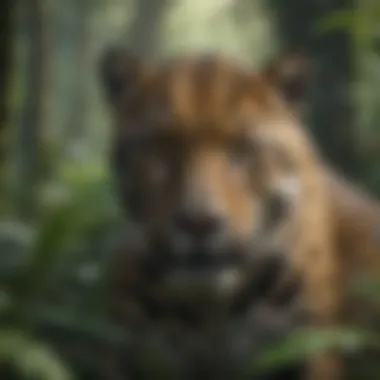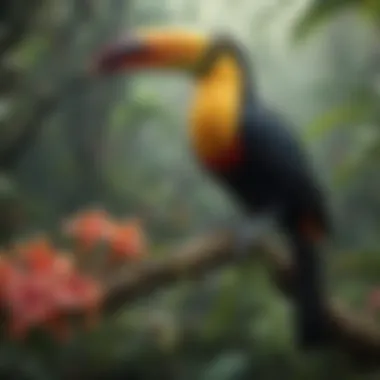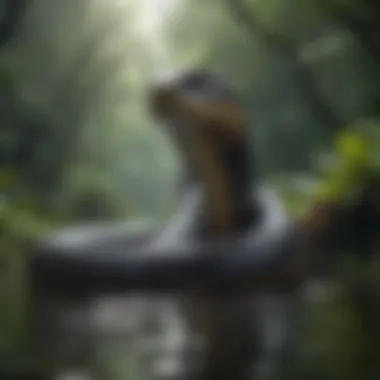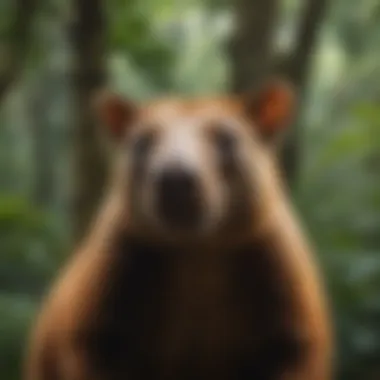Unveiling the Enigmatic Wildlife of the Rainforest Biome


Nature Topic Overview
The rainforest biome is a wondrous tapestry of life, teeming with a diverse array of captivating animals that have evolved remarkable adaptations to thrive in this complex ecosystem. From the vibrant canopy where colorful toucans flaunt their plumage to the mysterious depths of the forest floor where elusive jaguars prowl, each corner of the rainforest offers a glimpse into the interconnected web of life shaping our planet's biodiversity.
Wildlife Explorations
As you venture deeper into the heart of the rainforest, you'll encounter a myriad of fascinating species specially crafted by evolution to navigate this dense environment. Witness the acrobatic antics of spider monkeys swinging effortlessly through the dense canopy or the intricate dance of leaf-cutter ants as they forage for food on the forest floor. Learn about the symbiotic relationships between vibrant hummingbirds and exotic flowers, showcasing nature's delicate balance in this lush habitat.
Environmental Awareness
Conservation plays a vital role in safeguarding the rainforest's wealth of biodiversity for future generations. Discover the impact of deforestation on endangered species like the majestic harpy eagle and the critically endangered white-handed gibbon. Explore sustainable practices such as eco-tourism and habitat restoration efforts that aim to preserve the delicate equilibrium of this vital ecosystem. Empower young conservationists with actionable tips on reducing their carbon footprint and becoming stewards of the environment.
DIY Nature Activities
Engage in hands-on activities that bring the wonders of the rainforest into your home. Craft your miniature rainforest terrarium using moss, ferns, and miniature figurines to recreate a slice of this biodiverse habitat. Embark on a nature scavenger hunt in your backyard, identifying local flora, and fauna inspired by the rich diversity of the rainforest. Explore the art of leaf printing, utilizing fallen leaves to create striking botanical prints that capture the essence of nature's beauty.
Intro to Rainforest Biome
The rainforest biome is a mesmerizing ecosystem teeming with life, from the lofty canopy to the mysterious forest floor. This section serves as a gateway to understanding the significance of the rainforest biome in our exploration of diverse animal species. It unravels the intricate tapestry of this unique habitat, showcasing its key roles in sustaining life on Earth. By delving into the depths of the rainforest biome, we gain a profound appreciation for the interconnected web of species that call it home.
Definition and Characteristics
Equatorial Climate
The equatorial climate stands as a defining feature of the rainforest biome, contributing significantly to its unparalleled biodiversity. With consistent warmth and abundant rainfall throughout the year, this climate nurtures a multitude of plant and animal species, creating a haven for life to flourish. The unique aspect of the equatorial climate lies in its ability to support a wide array of specialized organisms adapted to its stable conditions, making it a prime focus of exploration in this article.
Dense Vegetation
Dense vegetation forms the lush green fabric of the rainforest biome, playing a crucial role in shaping its intricate ecosystems. The abundance of plant life not only provides habitats for diverse animals but also contributes to the regulation of essential ecological processes. The key characteristic of dense vegetation lies in its resilience and capacity to support a vast diversity of flora and fauna, making it a fundamental element in understanding the richness of the rainforest biome.
Biodiversity Hotspot
Renowned as a biodiversity hotspot, the rainforest biome encapsulates an astonishing variety of species within its boundaries. This hotspot status reflects the exceptional biological richness and endemism found in these lush environments. The key characteristic of being a biodiversity hotspot underscores the critical need for conservation efforts to preserve the irreplaceable genetic resources harbored within the rainforest biome.
Importance of Rainforests
The importance of rainforests transcends their intrinsic value, extending to profound contributions they make to the well-being of our planet. From carbon sequestration to biodiversity conservation and medicinal resources, these forests represent a treasury of ecological services that benefit both nature and humanity. This section sheds light on the invaluable roles played by rainforests in sustaining life and inspiring stewardship of these vital ecosystems.
Carbon Sequestration
Carbon sequestration stands at the forefront of the rainforest's ecological services, acting as a natural carbon sink that helps mitigate the impact of climate change. The key characteristic of carbon sequestration lies in the rainforest's ability to store vast amounts of carbon dioxide, thereby playing a pivotal role in regulating the Earth's atmosphere. This section explores the significance of this process and its implications for global carbon balance.
Biodiversity Conservation
Rainforests serve as bastions of biodiversity conservation, safeguarding a myriad of plant and animal species against extinction. The key characteristic of biodiversity conservation in these habitats lies in their role as reservoirs of genetic diversity, harboring species found nowhere else on Earth. This segment delves into the importance of preserving biodiversity in rainforests and the far-reaching consequences of its depletion.


Medicinal Resources
The rainforest biome is a treasure trove of medicinal resources, offering a vast array of plant-based remedies that support human health and well-being. The key characteristic of medicinal resources emanates from the diverse pharmacological substances derived from rainforest plants, holding potential for novel drug discoveries and treatments. This narrative explores the critical link between rainforest biodiversity and the field of medicine, highlighting the urgency of sustainable practices to safeguard these invaluable resources.
Layers of the Rainforest
The Layers of the Rainforest play a crucial role in understanding the intricate dynamics of this ecosystem. From the emergent layer to the forest floor, each level supports a diverse range of plants and animals, creating a rich tapestry of life. The canopy layer serves as a habitat for species such as tree frogs and epiphytes, while the understory layer hosts creatures like anteaters and fruit bats. Finally, the forest floor is home to predators like jaguars and giant anteaters, completing the multi-layered ecosystem of the rainforest.
Emergent Layer
Giant Birds
Giant birds in the emergent layer of the rainforest possess unique adaptations that allow them to thrive at great heights. Their large wingspan and strong beaks enable them to efficiently navigate the expansive skies, while their keen eyesight aids in hunting and spotting prey from afar. Despite their size, these birds exhibit remarkable agility in flight, showcasing a harmonious blend of power and grace.
Aerial Adaptations
Aerial adaptations displayed by various rainforest creatures play a vital role in their survival. From slender bodies for swift maneuvering to specialized feathers for aerodynamic efficiency, these adaptations enhance their ability to glide effortlessly through the dense vegetation. Such adaptations enable them to access food sources, evade predators, and locate suitable breeding grounds, ensuring their continued success in the challenging rainforest environment.
Canopy Layer
Tree Frogs
Tree frogs are masters of camouflage, blending seamlessly into the lush greenery of the canopy. Their sticky toe pads enable them to adhere to surfaces with ease, allowing them to traverse horizontally or vertically with precision. Known for their vibrant colors and melodious calls, tree frogs contribute to the enchanting ambience of the rainforest, playing crucial roles in insect control and ecosystem balance.
Epiphytes
Epiphytes, plants that grow upon other plants, thrive in the canopy layer by harnessing available sunlight and moisture. Their aerial lifestyle allows them to access resources that ground-dwelling plants cannot, creating flourishing microhabitats high above the forest floor. Epiphytes serve as hosts for a myriad of insects and small animals, fostering biodiversity and ecological resilience within the rainforest ecosystem.
Understory Layer
Anteaters
Anteaters in the understory layer possess specialized adaptations for feeding on ants and termites. Their elongated snouts and sticky tongues enable them to extract insects from their nests with remarkable efficiency. With sharp claws for digging and a keen sense of smell for detecting prey, anteaters play a crucial role in controlling insect populations, contributing to the ecological balance of the rainforest.
Fruit Bats
Fruit bats, essential pollinators and seed dispersers, play a vital role in the reproduction and propagation of plant species in the rainforest. Their nocturnal habits and keen sense of smell guide them to ripe fruit sources, promoting seed dispersal across vast distances. By consuming fruits and nectar, fruit bats support plant diversity and regeneration, ensuring the continued health of the rainforest ecosystem.
Forest Floor
Jaguars
Jaguars, apex predators of the rainforest, exhibit stealth and strength in their hunting strategies. Their distinctive coat patterns provide excellent camouflage amidst the dappled light of the forest, aiding them in ambushing unsuspecting prey. With powerful jaws and keen predatory instincts, jaguars maintain the delicate balance of prey populations, preventing overgrazing and preserving the ecosystem's health.
Giant Anteaters


Giant anteaters on the forest floor use their long tongues to extract ants and termites from mounds with remarkable precision. Their coarse fur acts as a protective shield against ant bites, enabling them to forage efficiently in pursuit of food. Despite their large size, giant anteaters display agility and speed when threatened, relying on their keen senses of smell and hearing to detect predators and avoid conflicts.
Iconic Animals of the Rainforest
In this segment, we delve into the significance of Iconic Animals in the Rainforest article. These remarkable creatures play a pivotal role in showcasing the biodiversity and uniqueness of the rainforest biome. By focusing on species like the Jaguar, Sloth, and Macaw, we can unravel the intricate web of life within this diverse ecosystem. The presence of these iconic animals highlights the fragility and complexity of the rainforest's ecology, serving as ambassadors for conservation efforts.
Jaguar
Apex Predator
Exploring the Jaguar as an Apex Predator sheds light on its crucial position in the rainforest food chain. With its powerful physique and predatory skills, the Jaguar exerts top-down control on the ecosystem, regulating prey populations and maintaining balance. The adaptability and hunting prowess of this feline make it a fitting choice for discussion in this article. A key characteristic of the Jaguar's role as an apex predator lies in its ability to influence the behavior of other species, shaping the dynamics of the rainforest ecosystem. Despite its advantages in population control, the Jaguar faces challenges such as habitat loss and human-wildlife conflicts, emphasizing the delicate balance of coexistence in the rainforest.
Stealthy Hunter
The Jaguar's role as a Stealthy Hunter exemplifies its strategic approach to hunting and survival. With a stealthy demeanor and keen senses, this elusive predator navigates the dense vegetation of the rainforest with precision. The Jaguar's unique feature of silent stalking and ambush tactics ensures successful hunts, reflecting its evolutionary adaptation to the rainforest environment. While the Jaguar's stealth is beneficial for securing prey, it also poses disadvantages in terms of human encounters and conservation efforts. Understanding the nuances of the Jaguar's hunting behavior provides valuable insights into the intricate connections between predator and prey dynamics in the rainforest.
Sloth
Slow-Moving Lifestyle
The Sloth's Slow-Moving Lifestyle epitomizes its adaptation to the laid-back rhythm of the rainforest. Through its leisurely pace and energy-efficient habits, the Sloth conserves energy in a nutrient-scarce environment. This unique characteristic of slowness not only allows the Sloth to thrive on a specialized diet but also acts as a defense mechanism against predators. The Sloth's gradual movements may seem disadvantageous, but they are integral to its survival in the competitive rainforest ecosystem.
Arboreal Adaptations
Discussing the Arboreal Adaptations of Sloths showcases their remarkable features for life in the tree canopy. From specialized claws for clinging to branches to a slow metabolism suited for a low-energy diet, Sloths have evolved unique traits for arboreal living. These adaptations enable Sloths to blend seamlessly into their treetop habitat, utilizing camouflaged fur to evade predators and ensure their safety. While Sloths may face challenges in terms of mobility and foraging efficiency, their arboreal adaptations are essential for their survival in the dynamic and vertically-layered rainforest environment.
Macaw
Colorful Plumage
Delving into the Colorful Plumage of Macaws reveals both their visual splendor and functional significance. From vibrant reds to dazzling blues, Macaws' vivid plumage serves various purposes, including attracting mates, camouflage, and species recognition. The key characteristic of their colorful feathers lies in their role as a form of communication and social signaling within the macaw community. Despite the advantages of their striking plumage in terms of social interaction and species identification, colorful feathers may also make Macaws more vulnerable to predators and illegal wildlife trade.
Seed Dispersal Role
Exploring the Seed Dispersal Role of Macaws unveils their critical ecological function in spreading seeds across the rainforest. As Macaws feed on fruits and nuts, they inadvertently transport seeds to new locations, aiding in plant regeneration and maintaining biodiversity. This unique feature of seed dispersal by Macaws highlights their role as ecosystem engineers, influencing the structure and composition of plant communities. While the seed dispersal service provided by Macaws is invaluable for rainforest regeneration, factors like habitat loss and poaching pose threats to their population and ecological contribution.
Lesser-Known Rainforest Species
In the expansive realm of rainforest fauna, the category of Lesser-Known Rainforest Species holds profound significance within the context of biodiversity exploration. While the spotlight often shines on iconic creatures like jaguars and sloths, delving into the realm of lesser-known species unveils a hidden tapestry of biological marvels waiting to be unearthed. These overlooked inhabitants play a crucial role in the intricate web of life in the rainforest biome, contributing uniquely to the ecosystem's equilibrium and diversity. By shedding light on these lesser-known gems, we can appreciate the depths of complexity and interdependence inherent in rainforest ecology.
Okapi
Giraffe Relative: The Okapi, known as the elusive 'Giraffe Relative,' stands out as a remarkable example of evolutionary adaptation within the rainforest habitat. Its distinguishing feature of zebra-like patterns and striking resemblance to both giraffes and zebras make it a riveting subject for exploration in this discourse. The Okapi's unique blend of characteristics, from its elusive nature to its distinct markings, underscores its ecological importance as a symbol of evolutionary specialization within the rainforest biome. Examining the Okapi's role as a Giraffe Relative reveals intriguing insights into the nuances of evolutionary divergence and adaptation, enriching our understanding of the diverse tapestry of rainforest species.
Zebra-Like Patterns: Delving into the intricate patterns adorning the Okapi's coat unveils a mesmerizing aspect of its biology that captivates biologists and nature enthusiasts alike. The zebra-like patterns not only serve as a visual feast for the eyes but also convey essential evolutionary adaptations that aid the species in camouflage and environmental blending. Unraveling the significance of these patterns in the context of survival and reproductive success illuminates the Okapi's prowess in navigating the challenges of its rainforest home. By examining the advantages and potential drawbacks of these distinctive markings, we gain valuable insights into the intricate balance between adaptation and ecological functionality in lesser-known rainforest species.


Kinkajou
Nocturnal Habits: The Kinkajou's intriguing nocturnal lifestyle serves as a captivating focal point in understanding the behavioral dynamics of rainforest inhabitants. Exploring the Kinkajou's nocturnal habits unveils a world of secrecy and mystery, where the cover of darkness provides a cloak for its unique behaviors and foraging strategies. The Kinkajou's preference for nighttime activities sheds light on the hidden dimensions of rainforest life, highlighting the diverse temporal niches occupied by its denizens. Analyzing the benefits and potential drawbacks of nocturnal habits in the context of rainforest survival enriches our comprehension of the adaptability and resilience displayed by these mesmerizing creatures.
Honey-Feeding Behavior: A closer inspection of the Kinkajou's honey-feeding behavior unveils a culinary delight that underscores its specialized niche within the rainforest ecosystem. The Kinkajou's affinity for honey not only reflects its dietary preferences but also showcases the intricate relationships between species and resources in the rainforest biome. By dissecting the unique features of honey-feeding behavior and its ecological implications, we gain a deeper appreciation for the Kinkajou's role as a pollinator and consumer within the dynamic food web of the rainforest. Exploring the advantages and challenges associated with this feeding behavior provides valuable insights into the delicate balance of symbiosis and competition shaping rainforest communities.
Glass Frog
Translucent Skin: The Glass Frog's intriguing translucent skin represents a marvel of nature that encapsulates the essence of elegance and evolutionary innovation. Through a detailed examination of this unique feature, we uncover the biological marvel of transparency that sets the Glass Frog apart within the realm of rainforest amphibians. The translucent skin of the Glass Frog not only charms beholders with its ethereal beauty but also offers a window into the inner workings of this enigmatic creature, showcasing the intricacies of its physiology and reproductive strategies. By elucidating the advantages and potential drawbacks of translucent skin in the context of survival and reproductive success, we gain insights into the adaptive wonders of lesser-known rainforest species.
Visible Organs: Peering into the Glass Frog's visible organs unveils a mesmerizing spectacle of anatomical transparency that invites us to marvel at the intricacies of its inner workings. The visibility of the Glass Frog's organs not only fascinates researchers and nature enthusiasts but also provides valuable insights into its physiological adaptations and evolutionary strategies. By exploring the significance of visible organs in understanding the Glass Frog's biology and ecological role, we unlock a treasure trove of knowledge regarding the intricate balance between form and function in rainforest organisms. Delving into the advantages and complexities of this unique anatomical feature enriches our understanding of the adaptive repertoire of lesser-known rainforest denizens.
Threats to Rainforest Animals
As we venture deeper into the riveting realm of rainforest animals, it is vital to shine a light on the looming threats that cast a shadow over their existence. The impact of human activities on these fragile ecosystems reverberates through the intricate web of life, jeopardizing the survival of countless species. By unraveling the layers of threats to rainforest animals, we gain a profound understanding of the precarious balance that sustains this biodiverse domain.
Deforestation
Habitat Loss
Within the tapestry of challenges faced by rainforest denizens, habitat loss emerges as a dark specter hastening the decline of iconic creatures. The rampant clearing of land for agriculture, logging, and infrastructure fragments once-unbroken expanses of forest, leaving animals stranded in isolated pockets of dwindling wilderness. The loss of critical habitats disrupts key ecological processes, imperiling the delicate interplay between fauna and flora. This insidious erosion of spatial resources threatens the very fabric of biodiversity, rendering survival a challenging feat for denizens of the rainforest.
Illegal Wildlife Trade
Among the harrowing threats lurking in the shadows of rainforest conservation looms the menace of illegal wildlife trade. Driven by greed and ignorance, this illicit industry devastates populations of vulnerable species to meet the insatiable demand for exotic pets, traditional medicines, and rare commodities. The clandestine networks executing these illicit transactions perpetuate a cycle of exploitation that undermines conservation efforts and undermines the delicate balance of ecosystems. The heinous trade in endangered wildlife not only decimates populations but also fuels criminal enterprises, perpetuating a cycle of destruction that imperils the future of rainforest fauna.
Conservation Efforts
Contemplating the intricate balance of life within the rainforest biome, conservation efforts emerge as a critical endeavor in preserving this ecologically diverse habitat. The symbiotic relationships between species and their environment underscore the necessity of safeguarding these invaluable resources. Conservation initiatives play a pivotal role in mitigating the impact of human activities on the delicate ecosystem. By raising awareness and implementing strategic measures, conservation efforts aim to ensure the sustained existence of rainforest animals for future generations.
Protected Areas
National Parks
National Parks stand as bulwarks of protection, shielding vulnerable species and their habitats from encroaching threats. Their intrinsic value lies in providing a sanctuary for a myriad of flora and fauna unique to the rainforest biome. These designated areas serve as bastions of biodiversity, allowing for the undisturbed coexistence of diverse ecosystems. The stringent regulations within National Parks facilitate scientific research, ecotourism, and the preservation of ecological balance. While offering a safe haven for endangered species, National Parks also foster environmental education and appreciation among visitors, cultivating a culture of conservation.
Reserves
In the realm of conservation, Reserves play a nuanced role in fortifying the resilience of rainforest fauna and flora. These designated areas, though often smaller in scale than National Parks, play a vital role in safeguarding specific species or habitats facing heightened endangerment. Reserves offer a more focused approach to conservation, tailoring management strategies to cater to the unique needs of the ecological communities they harbor. Through targeted conservation efforts and collaborative partnerships, Reserves contribute significantly to the overarching goal of ensuring the survival and vitality of rainforest ecosystems. While facing challenges such as limited resources and human encroachment, Reserves remain instrumental in the tapestry of conservation efforts, exerting a localized yet impactful influence in the preservation of biodiversity.
Ending
In the dense tapestry of rainforests, concluding our exploration unveils a profound respect for the intricate web of life. The essence of understanding rainforest biodiversity lies in recognizing our interconnectedness with the myriad species residing within. By delving into the realms of apex predators like the jaguar, the sloth's arboreal prowess, and the macaw's vibrant role in seed dispersal, we grasp the significance of preserving these unique ecosystems. Each creature, whether prominent like the jaguar or elusive like the kinkajou, plays a vital role in maintaining ecological balance, echoing the delicate dance of nature's intricate harmony.
Appreciating Rainforest Biodiversity
Need for Conservation
Embarking on the mission to safeguard rainforest biodiversity, the dire need for conservation emerges as a pivotal goal. Striving to mitigate the rampant habitat loss and curb the illegal wildlife trade, conservation efforts stand as beacons of hope in preserving the intricate tapestry of life. The critical aspect of conservation lies in its ability to harmonize human activities with the preservation of biodiversity. While challenges persist, the commitment to conservation remains a cornerstone of ensuring the sustenance of these invaluable ecosystems.
Human Responsibility
Within the narrative of rainforest biodiversity, human responsibility emerges as a defining ethos. Acknowledging our role as stewards of the environment, embracing sustainable practices and advocating for wildlife protection become imperative. The essence of human responsibility lies in fostering a harmonious coexistence with nature, recognizing our impact on the delicate balance of ecosystems. By instilling a sense of guardianship among communities and fostering environmental consciousness, we cultivate a legacy of preservation for generations to come.







